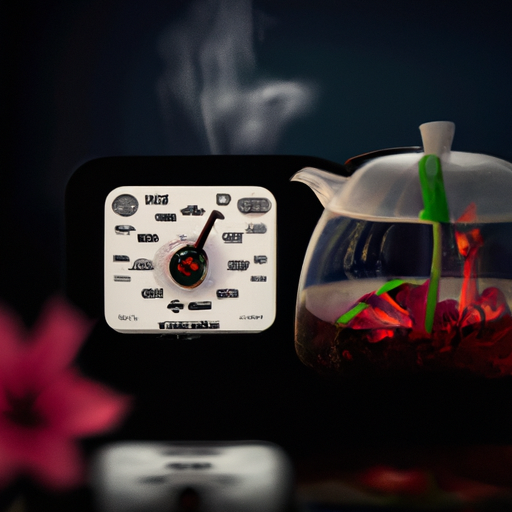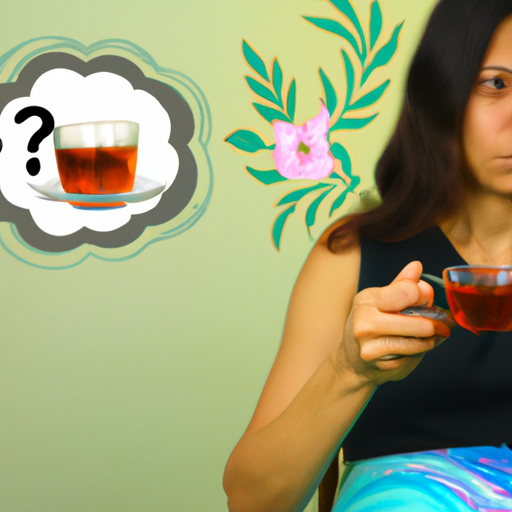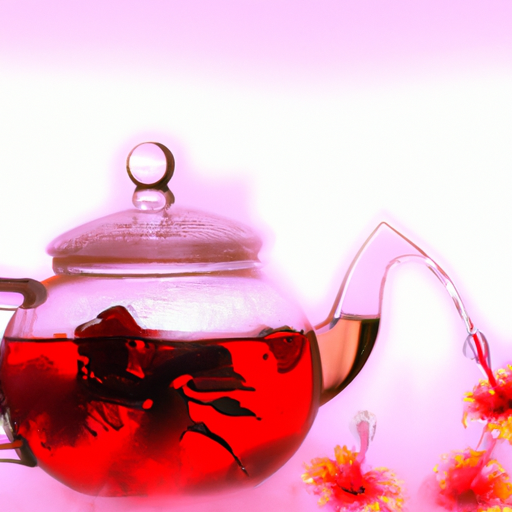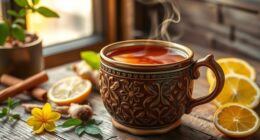As someone passionate about tea, I can confirm that the duration of steeping significantly impacts the taste and scent of your tea. Hibiscus tea, akin to other varieties, necessitates proper steeping time to unleash its complete spectrum of flavors and health advantages.
For instance, I remember brewing a cup of hibiscus tea for only two minutes once, and the result was an incredibly weak brew that lacked the tartness and fruity notes characteristic of this herbal infusion. This experience led me to research extensively on how long hibiscus tea should steep to achieve optimal flavor.
In this article, I’ll share my findings with you while also taking into account some essential factors that influence steeping time.
Key Takeaways
- Hibiscus tea should steep for 5-10 minutes in hot water before straining.
- Leaving hibiscus tea bags or loose leaves in too long can make the tea bitter and overpowering.
- Not allowing enough time for steeping can result in weak flavor.
- Water temperature should be between 90-95 degrees Celsius or 195-205 degrees Fahrenheit for steeping hibiscus tea.
The Importance of Steeping Time
Steeping time is key when making hibiscus tea, as it allows the flavor to develop and intensify. I’ve found that experimenting with steeping time can be a fun way to discover what works best for your taste buds.
Generally, hibiscus tea should steep for 5-10 minutes in hot water before being strained. However, there are factors that can affect the flavor of your tea during the steeping process.
For example, if you leave your hibiscus tea bags or loose leaves in too long, it can become bitter and overpowering. On the other hand, if you don’t allow enough time for steeping, the flavor may not be strong enough.
To find your perfect steeping time for hibiscus tea, start by following the general guidelines and then adjust based on personal preference. Consider factors such as temperature of water used and even altitude (higher altitudes may require longer steep times).
With a little experimentation and attention to detail, you’ll soon have a delicious cup of perfectly brewed hibiscus tea.
Factors That Affect Steeping Time
When it comes to steeping hibiscus tea, there are several factors that can affect the length of time needed for optimal flavor and health benefits.
One important consideration is the type of hibiscus tea being used – whether it’s loose leaf or bagged, dried or fresh, and how finely ground it is.
Additionally, water temperature plays a key role in steeping time, with hotter water typically requiring less time than cooler water.
Finally, personal preference also comes into play: some people may prefer a stronger brew with longer steeping times, while others may enjoy a milder flavor with a shorter infusion period.
Type of Hibiscus Tea Used
By using the right type of hibiscus tea, you can create a soothing and refreshing beverage that will transport you to a tropical paradise. When it comes to steeping time, the type of hibiscus tea used is an important factor to consider.
Here are four popular types of hibiscus teas and their recommended steeping times:
-
Whole Hibiscus Flowers: These flowers have a tart flavor profile and are packed with health benefits such as antioxidants and vitamin C. To extract their full flavor, steep 2-3 whole flowers in hot water for 5-7 minutes.
-
Hibiscus Tea Bags: Conveniently packaged in individual bags, these teas offer a milder taste than whole flower varieties but still have plenty of health benefits. Steep one tea bag per cup in hot water for 3-5 minutes.
-
Hibiscus Powder: This finely ground powder offers a strong and concentrated flavor that works well in baking or making drinks like smoothies. To make hibiscus tea from powder, whisk one teaspoon into hot water until fully dissolved.
-
Hibiscus Syrup: Perfect for sweetening cocktails or lemonades, this syrup is made by simmering equal parts sugar and water with dried hibiscus petals until thickened into a syrupy consistency.
Now that we’ve covered the different types of hibiscus teas, let’s move on to another important factor – water temperature – which plays a critical role in achieving the perfect cup of hibiscus tea.
Water Temperature
To get the perfect cuppa of hibiscus tea, it’s essential to pay attention to the water temperature. Hibiscus tea is made by steeping dried hibiscus flowers in hot water.
The boiling point of water is 100 degrees Celsius or 212 degrees Fahrenheit, but that doesn’t mean you should use boiling water for your hibiscus tea. Water that’s too hot can extract bitter compounds from the flowers and ruin the taste of your tea. To avoid this, let your boiled water cool down for a few minutes before pouring it over the flowers.
The ideal temperature range for steeping hibiscus tea is between 90-95 degrees Celsius or 195-205 degrees Fahrenheit. Steeping duration can vary depending on personal preference and desired strength of flavor.
When it comes to making the perfect cuppa of hibiscus tea, paying attention to details like water temperature can make all the difference. But don’t worry too much about getting everything exactly right – at the end of the day, it’s all about personal preference.
In the next section, we’ll explore how different factors like steeping time and added ingredients can affect the taste of your brew.
Personal Preference
Your personal taste preferences play a key role in determining the perfect cup of hibiscus tea for you. Whether you prefer your tea to be strong and robust, or light and delicate, there are a variety of brewing techniques that can help achieve your desired flavor profile.
Some people enjoy adding honey or lemon to their hibiscus tea for added sweetness and acidity, while others prefer it straight up. When it comes to preferred flavors, there is no right or wrong answer. It all depends on what tastes best to you!
However, some brewing techniques can enhance certain flavors in your hibiscus tea. For example, if you want a stronger brew with more depth of flavor, try using more tea leaves and letting it steep for a longer period of time. On the other hand, if you prefer a lighter and smoother taste, use less tea leaves and steep for a shorter amount of time.
Finding the right brewing technique is just one part of creating the perfect cup of hibiscus tea. Next up, we’ll explore how long to let your tea steep to achieve optimal results.
Recommended Steeping Time
Ah, the age-old question of how long to let that hibiscus tea steep for maximum flavor and enjoyment. Well, folks, let me tell you, the recommended steeping time is a mere 5-7 minutes. Any longer and you might as well be sipping on boiled potpourri.
It’s important to note that the recommended steeping time can vary depending on the type of hibiscus tea you’re using and personal preference.
When it comes to steeping techniques, there are several methods that can affect the overall flavor profile of your tea. For example, using boiling water may result in a stronger and more bitter taste compared to using slightly cooler water. Additionally, steeping for too long may lead to an over-extracted taste while not steeping enough may result in a weak flavor.
To achieve the perfect balance of flavor and aroma in your hibiscus tea, it’s best to follow the recommended steeping time of 5-7 minutes. This will ensure that you get all the health benefits without sacrificing taste. So, next time you brew yourself a cup of hibiscus tea, remember to set your timer and enjoy every sip without worrying about over-steeping or under-steeping.
When it comes to making a perfect cup of hibiscus tea, knowing how long to let it steep is just one part of the equation. In my next section, I’ll share some tips on how to properly prepare your hibiscus tea for maximum flavor extraction without compromising its natural goodness.
How to Steep Hibiscus Tea
When it comes to steeping hibiscus tea, there are several methods to choose from. As a tea lover, I’ve tried them all and have found three popular ways: the loose leaf method, teabag method, and concentrate method.
Each of these methods has its own advantages and disadvantages, so let’s dive in and explore each one in detail.
Loose Leaf Method
To properly steep loose leaf hibiscus tea, you’ll want to use a strainer or infuser to prevent any bits of leaves from getting into your cup. Loose leaf tea is known for its superior quality and higher concentration of antioxidants, making it the best choice for health benefits. When using loose leaf tea, it is important to use the right brewing equipment to ensure that the tea leaves have enough room to expand and release their full flavor.
I recommend using a tea ball infuser or mesh strainer when steeping loose leaf hibiscus tea. This will allow the hot water to flow through the leaves evenly while keeping them contained in one place. Simply add your desired amount of loose leaf tea into the infuser/strainer, place it in your mug or teapot, pour hot water over it, and let it steep for 5-7 minutes before removing the infuser/strainer.
Now that you know how to properly steep loose leaf hibiscus tea, let’s move on to exploring the teabag method for those who prefer convenience without sacrificing taste.
Teabag Method
For those who prefer a more convenient option, the teabag method offers a hassle-free way to enjoy the rich flavor and health benefits of hibiscus tea. Compared to loose leaf tea, teabags are pre-portioned and often come in individual sachets, making them ideal for on-the-go or single servings. However, it’s important to note that teabag quality can vary greatly depending on the brand and type.
Here are some key factors to keep in mind when using the teabag method for hibiscus tea:
-
Steeping time variations: Depending on the brand and strength of your teabags, steeping times can range from 3-10 minutes. It’s always best to follow the instructions provided by the manufacturer.
-
Teabag vs Loose Leaf: While loose leaf tea is often considered superior in taste and quality compared to bagged teas, there are still high-quality teabags available that can produce delicious results.
-
Water Temperature: For optimal extraction of flavor and health benefits, water temperature should be around 195°F (90°C).
-
Experiment with ratios: If you find your tea too weak or strong, try adjusting the ratio of water to tea bags until you achieve your desired taste.
Moving onto our next section about the ‘concentrate method’, let’s explore another way to make hibiscus tea that offers unique advantages.
Concentrate Method
If you’re looking for a time-saving method to make hibiscus tea, the concentrate method is perfect for you. Rather than steeping individual tea bags or loose leaves, this method involves cold brewing a concentrated batch of tea that can be stored in the fridge and used over several days. Here’s how it works:
First, gather your brewing equipment. You’ll need a large pitcher or jar (at least 1 quart), a fine-mesh strainer or cheesecloth, and 3-4 hibiscus tea bags or 1/2 cup of loose hibiscus flowers. Add the tea bags or flowers to the pitcher/jar and fill with cold water. Cover and let sit in the fridge for at least 6 hours (or up to overnight) to allow the flavors to infuse into the water. When ready, strain out any solids using your strainer/cheesecloth and discard them. The resulting concentrate should be stored in an airtight container in the fridge until ready to use.
To achieve optimal flavor when using your concentrate, try adding 1 part concentrate to 2 parts hot water (or more if desired) before serving. This will dilute the strong flavors of the concentrate and give you a perfectly balanced cup of hibiscus tea every time!
How to Achieve Optimal Flavor
Hey, you want your hibiscus tea to taste like the nectar of the gods, right? Well then, steep that bad boy for at least 5 minutes and watch the flavor explosion happen.
To achieve optimal flavor infusion, it’s important to use proper brewing techniques. For example, using boiling water instead of just hot water can help release more of the tea’s natural oils and flavors. Additionally, make sure to cover your tea while it steeps. This will help retain heat and ensure that all of those delicious flavors are fully extracted from the hibiscus flowers. Don’t be afraid to experiment with different steeping times too! Depending on your personal preference, you may find that a slightly longer or shorter steeping time works best for you.
So now that you know how to brew the perfect cup of hibiscus tea for maximum flavor, let’s move on to some other great benefits this drink has to offer.
Did you know that drinking hibiscus tea can help lower blood pressure and cholesterol levels? It can also boost immune system function and reduce inflammation in the body.
So go ahead and enjoy a cup (or two) knowing that not only does it taste amazing but it’s also doing wonders for your health!
Health Benefits of Hibiscus Tea
Discover the amazing health benefits of sipping on a delicious cup of hibiscus tea! It can reduce inflammation and boost your immune system. Hibiscus tea is packed with antioxidants and vitamin C, making it a great choice for those looking to improve their overall health.
Studies have shown that consuming hibiscus tea can help lower blood pressure levels in individuals with hypertension. If you’re interested in trying out some hibiscus tea recipes, there are plenty of options available online. From iced teas to hot brews, there’s no shortage of ways to enjoy this refreshing and healthy beverage.
One popular recipe is to mix hibiscus tea with ginger and honey for added flavor and health benefits. It’s important to note that while hibiscus tea has many potential health benefits, it should not be used as a substitute for medication or medical treatment.
Additionally, individuals who are pregnant or taking certain medications should consult with their healthcare provider before consuming hibiscus tea. With these considerations in mind, incorporating hibiscus tea into your diet can be a great way to support your overall wellness.
As we move onto the next section about common mistakes to avoid, keep in mind how incorporating hibiscus tea into your routine can benefit your health without relying solely on it as a cure-all solution.
Common Mistakes to Avoid
Avoid making these mistakes to ensure you get the most out of your hibiscus tea and improve your overall wellness. One common mistake is oversteeping the tea, which can result in a bitter taste and loss of nutrients. To avoid this, make sure to steep for no longer than 5-7 minutes.
Additionally, be mindful of the water ratio when brewing. Using too much water can dilute the flavor and benefits. Brewing hibiscus tea doesn’t have to be complicated. For a refreshing twist, try cold brewing by adding loose leaves or tea bags to cold water and letting it sit in the fridge overnight. This method creates a milder flavor with less acidity compared to hot brewing. If you prefer a sweeter taste, add honey or stevia instead of sugar as they contain natural antioxidants.
Now that you know how to properly brew hibiscus tea, let’s talk about storing and serving it. To keep its freshness and potency, store in an airtight container away from direct sunlight or moisture.
When serving hot, pour into your favorite mug or teapot with slices of lemon or ginger for added health benefits. As for iced tea lovers, garnish with fresh mint leaves or berries for a flavorful touch.
Storing and Serving Hibiscus Tea
To ensure maximum freshness and potency of your hibiscus tea, it’s important to store it properly. I recommend storing the tea in an airtight container away from direct sunlight or moisture. This will help preserve the flavor and prevent any potential spoilage. You can also consider adding a small packet of silica gel to help absorb any excess moisture.
When it comes to serving hibiscus tea, there are many ways to add some extra flair. For hot tea, try adding a slice of lemon or a sprig of fresh mint for added flavor and aroma. If you prefer iced tea, consider adding in some sliced fruit like strawberries or peaches for a refreshing twist on this classic drink. You can also experiment with different sweeteners such as honey or agave nectar to find your perfect balance of sweetness.
Don’t be afraid to get creative with your presentation! Serve your hibiscus tea in elegant glassware and garnish with colorful edible flowers for an Instagram-worthy beverage that is sure to impress. By following these simple storing tips and serving suggestions, you can enjoy delicious and flavorful hibiscus tea all year round!
| Serving Suggestions | Storing Tips | ||
|---|---|---|---|
| Add lemon slices or fresh mint leaves | Store in an airtight container | ||
| Try sliced fruit like strawberries | Keep away from direct sunlight | ||
| Experiment with sweeteners like honey | Consider using silica gel packets | ||
| Garnish with edible flowers for extra flair | Avoid exposing the tea to moisture | To enhance the flavor, steep the tea for at least 5 minutes before serving. |
Frequently Asked Questions
What are the different types of hibiscus tea and how do they affect steeping time?
When it comes to hibiscus tea, there are a variety of different flavors available. Some popular options include traditional hibiscus, as well as blends with fruits like raspberry or orange.
Each flavor may require slightly different brewing techniques, which can impact the steeping time. For example, some varieties may benefit from a longer steeping time to bring out their full flavor profile, while others could become bitter if left in the water for too long.
As someone who’s tried many different types of hibiscus tea, I can confidently say that experimenting with various steeping times and temperatures is key to finding the perfect cup for your taste preferences.
Can hibiscus tea be steeped more than once?
Did you know that hibiscus tea is the second most popular herbal tea in the world, after chamomile? When it comes to steeping this delicious and healthy beverage, many people wonder if it’s possible to brew multiple cups from the same leaves.
The answer is yes! Hibiscus tea can be steeped more than once, but there are some important things to consider. Multiple steepings will likely result in a weaker flavor, as much of the active compounds are already extracted during the first infusion.
However, some people enjoy exploring how flavor changes with each additional steeping. If you’re going for maximum health benefits, stick to one or two infusions and discard the leaves after that.
Is it necessary to use a specific type of water when steeping hibiscus tea?
When it comes to steeping hibiscus tea, the type of water you use can make a difference in the taste. Some people prefer using filtered water, while others opt for mineral water.
Both types of water have their advantages and disadvantages. Filtered water is free from impurities and contaminants, resulting in a cleaner taste. On the other hand, mineral water contains natural minerals that add flavor and depth to the tea. However, it’s important to note that certain minerals found in mineral water may affect the color and taste of hibiscus tea.
Ultimately, it comes down to personal preference which type of water you choose for steeping hibiscus tea.
Can hibiscus tea be consumed cold and if so, how does this affect steeping time?
I love drinking hibiscus tea, especially on hot summer days. What I find fascinating about this tea is that it can be consumed both hot and cold.
When it comes to the steeping process, there are some differences between hot and cold consumption. For cold consumption, you don’t need to steep the tea for as long as you would for hot tea. This is because when brewing hibiscus tea with hot water, the heat extracts more of its flavor and nutrients from the dried flowers.
However, when making iced hibiscus tea, you can go for a shorter steeping time of around 5-10 minutes since you want to avoid over-extracting bitterness from the flower petals. Once brewed, let it cool down completely before serving over ice or storing in the fridge for later use.
Are there any potential side effects or risks associated with consuming hibiscus tea?
When it comes to consuming hibiscus tea, there are some potential risks and precautions that should be taken into consideration. Some studies suggest that drinking large amounts of hibiscus tea may lower blood pressure, which could be problematic for individuals who already have low blood pressure or are taking medications to lower their blood pressure.
Additionally, hibiscus tea may interact with certain medications, so it’s important to speak with a healthcare provider before incorporating this beverage into your daily routine.
As with any food or drink, moderation is key and it’s always wise to err on the side of caution if you’re unsure about how much hibiscus tea is safe for you personally to consume.
Conclusion
In conclusion, hibiscus tea is a delicious and healthy alternative to sugary drinks that can be enjoyed at any time of the day. It’s important to steep it for the right amount of time to ensure optimal flavor and health benefits. The recommended steeping time for hibiscus tea is 5-7 minutes, but this may vary depending on personal preference and other factors.
Remember, the longer you steep your tea, the stronger and more bitter it may become. So, take the time to experiment with different steeping times until you find your perfect cup of hibiscus tea. And don’t forget to store it properly in an airtight container and serve it chilled or hot, depending on your preference.
With these tips in mind, you’ll be able to enjoy a refreshing cup of hibiscus tea that not only tastes great but also provides numerous health benefits.










